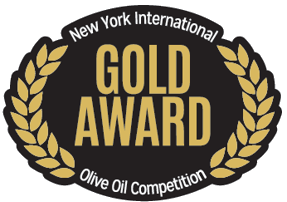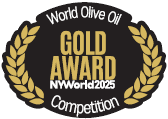Growing California’s Liquid Gold – An interview with Karen and Malcolm Bond of Winters
An interview with Karen and Malcolm Bond of Winters
OCT 24, 2023
Hello, Cooks and Readers – Today’s interview is my second with a couple, rather than an individual: Karen and Malcolm Bond, the producers who make Bondolio olive oil. The Bonds actually have two businesses (they are also co-founders of a medical software company), so they’re very busy, especially around olive harvest season, but they took time a few weeks ago to tell me about how they started making their hand-harvested, organic olive oils (hint: importing trees to plant from outside the US is no joke!), how they learned to appreciate good food, and what they do with their oil.
Karen also shared her recipe for olive oil-poached artichokes—a method she learned while traveling in Italy. I’ll share that recipe in a few days. In the meantime, here’s what the Bonds told me about cooking and starting and olive grove, edited and condensed slightly for length and clarity.
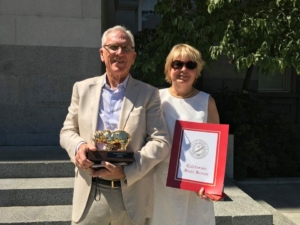
Karen and Malcolm Bond
Karen and Malcolm Bond
Karen:
I grew up in New Jersey, and as a child, I always wanted to move to California. In 1983, I finally moved here.
Malcolm:
Karen left out that she normally introduces herself as a nice Italian girl from New Jersey. We met each other shortly after Karen moved from the east coast. It was a high-speed office romance.
I’m a fourth-generation Californian in the Bay Area. My great-great-grandmother arrived here in a covered wagon via Oregon. I think they were chased out of St. Louis because they were stealing horses or something like that. That’s what I was told. Before that, they’re Norwegian and English.
Karen:
My mother was a fairly good cook, and she cooked everything. I remember her making sweet and sour shrimp, spaghetti, and roast beef with Yorkshire pudding. My mother is English; her father was born in the UK. Once a month, we would go to Philadelphia and eat at a different restaurant, whether it was Chinese, Italian, or Jewish—all kinds of food.
Malcolm:
I grew up in a house where both my parents had careers. My mother broke glass ceilings in the fifties; she became a regional store manager for a chain of grocery stores in Southern California. So, in our house, we always had access to awesome fresh food—fresh vegetables and fruit and good meats.
But my introduction to what food could be was in high school, when I worked for a caterer—one of the most sought-after caterers in Hollywood. I would dress up and be there during food prep and then help serve for elite Hollywood producers and fashion designers.
Karen:
I never really cooked with my mother. I mostly did the dishes. But in college, I just started cooking. I think I don’t think I was ever really taught how to cook. I just kind of knew. I make a lot of pastas. I think I make a really mean risotto; I think I learned how to make it from a book on Venetian cooking.
Malcolm:
I cook on the morning shift. Around a quarter to five, I’ll start making breakfast and cappuccinos for Karen. I’ve been doing that, I think, for 38 years. It’s been my job. And I don’t think I’ve ever skipped a breakfast once—otherwise I’d hear about it.
Karen:
When I moved here, the biggest disappointment about California was Italian food. Growing up in the Philadelphia area, we had fabulous Italian food at restaurants, and because I lived in an Italian neighborhood, everybody cooked Italian. Here, it’s a California Italian, not a real Philadelphia Italian, or New York, or Boston. I think those three cities have the best Italian food. In California, the pastas always had a lot of vegetables in them. It was more California cuisine, not real Italian. Things are getting better now, but when I first moved here, especially in the Sacramento region, there weren’t any good restaurants.
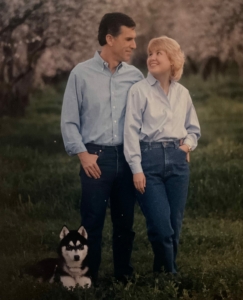
Malcolm and Karen circa 1987
Malcolm:
Shortly after we were married, a piece of property came up for sale that was a small farm—a ten-acre farm—of almonds not too far from Davis, where we were living. We bought this little farm thinking that we would build a small home and live more of a rural life—a big enough property for a large vegetable garden for Karen.
There were about a thousand almond trees, planted in the late 1940s. They’re fun trees to look at when they’re in bloom. The problem was that with almonds, on a small scale, it doesn’t pencil out on the numbers. After 10 years harvesting the almonds and selling to a large co-op, it was still just in the red every single year. So, we started to pull the almond trees out and prepare the ground for a new orchard. We were thinking either plums or a new hybrid of almonds or something other locals grew.
Shortly after that, however, we were in southern Italy at a B&B. It was Christmas 1999. One morning, the owner asked Karen if she’d like to follow her out of town to her farm to taste her olive oil that was just made the night before. That was a big deal for Karen, because one of the things we would always bring back from Italy was olive oil. So, we drove into her orchard of very old, gnarly looking olive trees and went to her stone barn. The woman broke off a piece of bread and drizzled this yellow-green cloudy liquid onto it. Karen popped it in her mouth, and the smile on her face said it all. She loved it. It was the first time she had tasted fresh olive oil, and I think her palate just had to wake up and remember her ancestry. I think that all happened just in a microsecond as this fresh olive oil hit her palate and her throat.
And when we left, we went even further south, and we start to look at family farms. They always had chickens and a pig or two, they always had a small vineyard, and they always had olive trees. So, we just started to talk. Could we do something like this? Was it possible that we could recreate what Karen had tasted back home in California? As we looked around, we realized that the terrain and natural flora was a lot like back home. So, we thought, Well, let’s give it a go.
We started collecting all the oils we saw, and after dinner we’d do a blind tasting. It turns out that for Karen’s palate, she likes an oil with at least one of three cultivars from Sicily.
Karen:
Nocellera, Biancollila, and Cerasuola. They were fruity and grassy, and that’s exactly what I wanted in our olive oil.
Malcolm:
So, I thought, Easy. I’ll just go back home, start calling nurseries, and order up 1,200 of these trees.
And then we had a roadblock. Everyone said, “I’m sorry, but those trees do not exist here.” So, we applied for and got permits from the federal FDA and the California FDA to import live plant material. Once we had that in hand, we went back looking for a nursery that could propagate these three cultivars and export them to California.
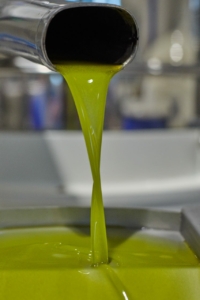
Freshly pressed olive oil (yes, it’s always green!)
Karen:
We got the first shipment from a grower who said they had shipped to the U.S., and we get a call when they arrive from the Department of Agriculture: “Come down to the San Francisco airport, we have a problem.” We go there, and they take Malcolm through a series of clean rooms, and they open up the box and show him that soil was on the roots. And you’re not allowed to import any soil with plant material. So, they opened up an incinerator and threw in all the plants and burned them.
Malcolm:
I don’t like to tell that story, because a man isn’t supposed to openly cry, but that’s what happened. Once the box of our little plants was incinerated in front of me, I cried. The technician put his arm around me and said, “Don’t worry, here’s some more detail on what they have to do to meet our import requirements for live plant material. You’ll get this done, I’m sure of it.”
So, we went back searching for a new nursery. We found a wonderful group of people outside of Florence that would not only propagate but also helped us plan the organization of the orchard and introduced us to a fourth varietal that would actually help these self-pollinating olive trees pollinate themselves. So, at the end of the day, it was fortuitous, because we got to meet some people that became good friends of ours. When that second batch of young plants arrived, customs called, and they were happy with them.
Thank you for reading the California Table! This post is public, so feel free to share it.
Karen:
The plants arrived on Christmas Eve 2007, on a Lufthansa flight at 1pm. And on Christmas Day, I cooked dinner, and we had the whole family and a few friends plant 1,250 trees in two-inch pots. And it was a beautiful, sunny Christmas Day.
The trees had to be quarantined, so they had to go into a greenhouse. And the department of agriculture—the feds as well as the California inspectors—would come and inspect and pull a plant out by its roots and take it with them. And we would never hear anything in the meantime. They were still quarantined after two years, and we had to transplant the trees to five-gallon pots, because we still didn’t have permission to plant the trees yet. Finally, in 2010, they went in the ground. So, in total, that was a 10-year process to get the trees in the ground.
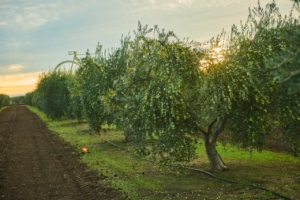
Bondolio Farm
Karen:
Now we work on the farm evenings and weekends. Malcolm does the pruning of the trees every year because people don’t seem to know how to prune trees properly, even when we train them; we want to do it the old-fashioned way. So, he does all the pruning. We planted our trees 25 feet apart from each other, and we bowl out the centers so that we have no fruit flies. Our fruit is beautiful at harvest.
Olive oil is like wine. Certain olive oils go with great with different foods. Our olive oil tends to be a very versatile olive oil. There was a chef at Zuni Cafe who would buy our olive oil every single year who made a dinner for us and told us that we had the most versatile olive oil. He proved it to us by starting with a persimmon salad, then making fish, then a chocolate sorbet with our olive oil on top. He said we had the most versatile California olive oil.
Malcolm:
It’s a buttery, fruity, complex olive oil with a peppery finish.
During harvest time we’re slammed taking care of the harvest and getting the fruit to the mill. We have about 60 people that we hire to come and handpick everything, and it takes about five days. We installed our own mill seven years ago. We try to keep the time between picking and processing the olives to within 90 minutes.
We also have a vegetable garden. It’s a little on the large side, but it’s important for Karen. We didn’t do the full animal farm kind of a thing that we saw in Italy, but we did add grapes a small vineyard.
Karen:
And we did get chickens. They had the run of the entire orchard. That was a lot of fun.
Photos: Courtesy of Karen and Malcolm Bond

